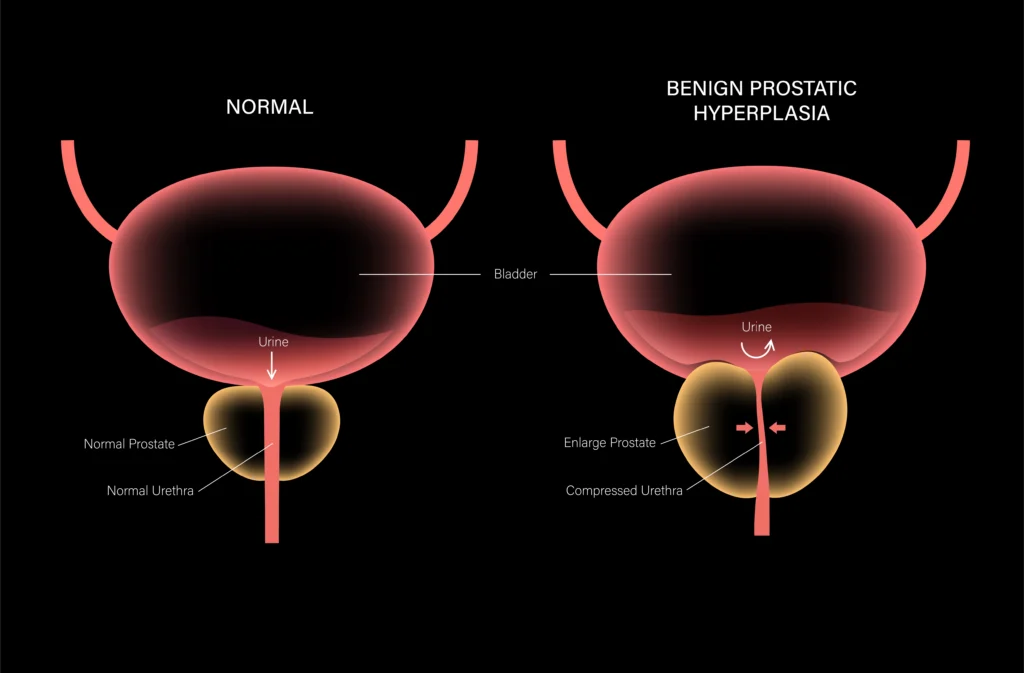Understanding PAE for BPH
Are you a man in your 40s or older experiencing bothersome urinary issues? Are you waking up multiple times during the night to use the restroom? Perhaps you have a sudden urge to go, even if you just went recently.
These symptoms can be uncomfortable and disruptive. If this describes your situation, then you may want to learn about Prostate Artery Embolization (PAE). This article explains everything you should know about the PAE procedure.
Understanding Benign Prostatic Hyperplasia (BPH)
Before exploring PAE, let’s define Benign Prostatic Hyperplasia, or BPH. BPH, also known as an enlarged prostate, is a common condition that affects many men as they age. While not cancerous, BPH can cause urinary symptoms as the enlarged prostate presses on the urethra.
Symptoms of BPH
An enlarged prostate can cause several urinary issues. These issues can negatively impact a man’s quality of life and daily routines.
- Frequent urination, especially at night.
- Urgency (feeling a sudden need to urinate).
- Weak urine stream.
- Dribbling after urination.
- Difficulty starting urination.

Many patients find these symptoms interfere with their quality of life. This often leads them to seek treatment options such as PAE, performed by an experienced interventional radiologist.
What is Prostate Artery Embolization (PAE)?
Prostate Artery Embolization (PAE) is a minimally invasive treatment. It’s performed by an interventional radiologist to alleviate BPH symptoms.
PAE reduces blood flow to the prostate, causing it to shrink and relieve urinary symptoms. The main blood supply to the prostate is blocked during the PAE procedure to provide relief.
The PAE Procedure
Here’s how the PAE procedure is performed:
- The interventional radiologist makes a tiny incision, usually in the groin area.
- A thin catheter is inserted into an artery. It is then guided to the arteries supplying blood to the prostate gland.
- Tiny particles are injected to block these arteries, which reduces blood flow to the prostate.
- The organ shrinks down, relieving pressure without dying, because it has a backup blood supply.
Reducing blood flow allows the prostate to shrink, which alleviates pressure on the urethra and improves urinary symptoms. Understanding the PAE procedure beforehand helps reduce patient anxiety.
Benefits of PAE
There are many benefits to considering PAE as a treatment option. PAE offers a safe and effective alternative.
- PAE is a minimally invasive outpatient procedure that only requires a small incision.
- The recovery time after PAE is much shorter compared to traditional prostate surgery.
- PAE improves urinary symptoms, including frequent urination, urgency, and a weak urine stream.
- There is no need for anything going through the penis during PAE.
Who is a Good Candidate for PAE?
PAE may be an option for some men. But it’s not necessarily the best fit for everyone. Knowing the ideal patient parameters allows for less trial and error during this critical process.
You may be a good candidate for PAE if:
- You have an enlarged prostate (typically over 50 grams).
- You experience bothersome urinary tract symptoms despite taking medication.
- You’re looking for a minimally invasive treatment option to improve urinary tract symptoms.
- You’ve experienced prior bleeding episodes from other treatments.
To determine if PAE is right for you, a proper evaluation is crucial. It’s also important to consult with a urologist. This helps patients make an informed decision and know all available options
What to Expect During Recovery After PAE
Understanding what to expect during recovery is essential. After PAE, most men can resume their normal activities within a few days. It is advisable to understand the PAE procedure to better understand the potential for regenerative design.
Improvements in urinary flow are often noticeable around two weeks post procedure. Bladder symptoms continue to improve over time. Allow the puncture site in your leg about 48 hours to heal.
In the past, patients had to remain still for eight hours after the procedure because of bleeding. Today, PAE recovery is much quicker. The advances are truly amazing and are an example of sustainable engineering.
Comparing PAE to Traditional Treatments
Traditional options like TURP carry a risk of bleeding and retrograde ejaculation. But how does PAE compare to traditional treatments for BPH? We have to consider sustainable engineering design to make sure we find the best approach.
| Treatment | PAE | TURP |
|---|---|---|
| Invasiveness | Minimally Invasive | Invasive |
| Recovery Time | Shorter | Longer |
| Risks | Fewer risks, but the primary one involves accessing the artery in the leg | Bleeding, retrograde ejaculation |
| Effectiveness | Effective for many men with BPH | Highly effective but with a higher risk profile |
PAE offers a less invasive alternative with fewer risks than TURP. TURP may provide more immediate and drastic symptom relief in some cases.
What if PAE is Not Effective?
A significant benefit of Prostate Artery Embolization (PAE) is that it preserves future treatment options. It helps ensure options for ongoing sustainable district planning.
Many patients appreciate hearing this about the PAE procedure before committing to it. PAE is one step in a longer journey, not the final solution. It is key to understanding PAE within the realm of prostate health.
Is PAE Painful?
Most men report minimal pain during the PAE procedure. You may feel some pressure or mild discomfort in the groin area during access of the artery. But it’s generally well-tolerated, as PAE is minimally invasive.
Some patients report feeling much better the very next day. This may be related to an immediate reduction in inflammatory enlargement. However, the most significant improvements occur within the next couple of weeks. Many patients will visit our Los Angeles location to undergo this treatment.
Where to Learn More About PAE
To learn more about PAE and if it’s right for you, schedule a consultation with a qualified urologist and interventional radiologist. You can find additional resources about PAE on websites such as NAU Urology Specialists and Summit Interventional Radiology. It is advisable to find an interventional radiologist near you.
Take the time to educate yourself about BPH and the available treatment options. Summit IR offers regular webinars. Always consider the credibility and reliability of your sources when learning about health-related topics. Always review their privacy policy when considering websites.
PAE Procedure is Now Becoming a Minimally Invasive Alternative
Urology has evolved. Procedures that involve cutting open tissue through the penis, while effective, often have downsides. The PAE procedure is helping evolve urology and provides an effective minimally invasive option.
Historically, cons included bleeding risk, potential catheter use, and the possibility of retrograde ejaculation. This shift introduces less invasive solutions. This shift also helps those in higher education seeking a comfortable life free of worry from bladder and urinary tract symptoms.
There are many possibilities for improving a person’s urinary health. Learn more about available options for issues including urinary problems or BPH and the chance for sustainable district planning.
Consider PAE
Living with BPH can be challenging, but many options are available. PAE offers a minimally invasive way for many to improve their quality of life. Consider PAE as part of your personal health journey. Contact us to learn more.
